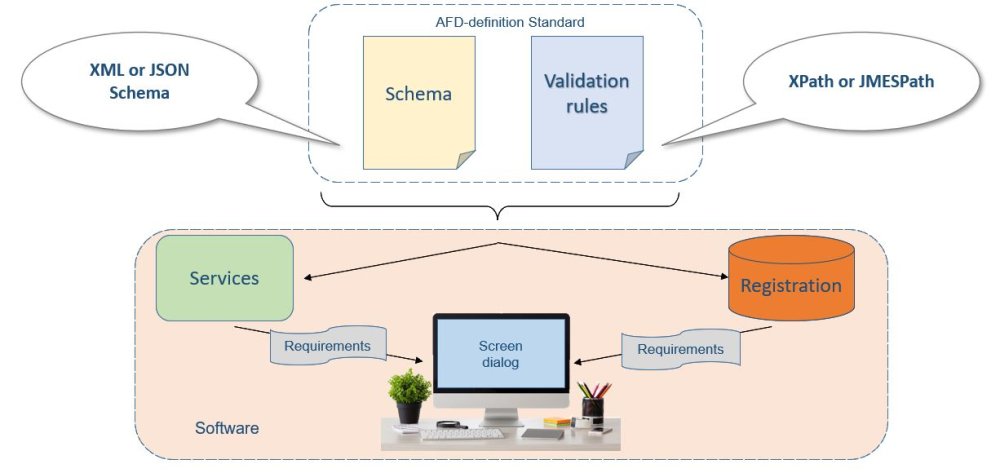Introduction
The digitization of insurance processes continues unabated. Applications and data exchange are becoming more complex. This makes proper use of concise, manageable specifications essential. The system of XML templates currently used in the sector, only allows checking the AFD entities, attributes and their nesting. Additional specifications are currently supplied in text, which is laborious and error-prone. All taken together, this offers insufficient support for the effective validation of messages and recording of data. The AFD-definition Standard provides a framework for specification and validation in two parts, based on industry standards:
- JSON Schema: for defining specifications of messages regarding structures, entities and attributes. The use of JSON Schema promotes the preparation of unambiguous specifications. In addition, JSON Schema can be used as a basis for automated checking of messages, databases and dialogues.
- JMESPath: for defining specifications of relationship checks between attributes that cannot be specified in JSON Schema. The use of JMESPath definitions promotes the creation of unambiguous specifications.
The combination of the two elements above provides a precise AFD-definition that can be supported by various (often freely available) software libraries. Their use by developers is simple and results can be achieved quickly. The introduction of the AFD-definition Standard is an important step forward for the insurance industry when it comes to handling services and recording data. The improved standard promotes data quality and efficiency of distribution chain processes.
Reference architecture AFD-definition Standard
The reference architecture in the figure below illustrates the processes and the cohesion between the components.
4-1-reference-architecture-afd-definition-standard

Based on the AFD-definition Standard, JSON Schemas and AFD relational checks are drawn up for an insurance product for applicable services (e.g. premium calculation) and/or registration (policy recording). Schemes and validation rules are made available by the provider.
Once made available, the software developer can retrieve these AFD-definitions and process and/or store them within the application’s environment.
The JSON Schemas and AFD relational checks provide support for developers to develop software in a structured and uniform way, for example, for comparison software or insurance software. The goal is to create largely configurable software for:
- Setting up screen dialogs
- Validating web service calls
- Validating of storage of AFD messages for storage in the form of unstructured data
The description of the reference architecture in case of XML is available in the AFD-definition Standard manual (in Dutch).
Goals
The use of both JSON Schema and JMESPath ensures that an AFD message can be checked completely in JSON. The set of rules concerning the structure, content and relationship checks improves the data quality of the message. The lower failure rate of these messages due to less incorrect or incomplete data will lead to more efficient processes in the distribution chain.
Effects of implementation of the AFD-definition Standard:
- Simplification of product specification management
By standardizing tools and rules to be developed, developers receive support in software development. - Improvement of data quality in messages and databases
The checks on data during storage and message exchange will prevent incorrect and incomplete messages. - More user-friendly dialogs
Following the defined product structure and checks at screen dialogs will ensure an improved interaction with the user and therefore also a better input quality of data. - More efficient implementation of processes
Development time will decrease thanks to the flexible configuration of products in software. - Shortened time-to-market for implementations and changes
Less development time will also mean a shorter implementation time.
This chapter discusses the use of JSON Schema and JMESPath.




Post your comment on this topic.